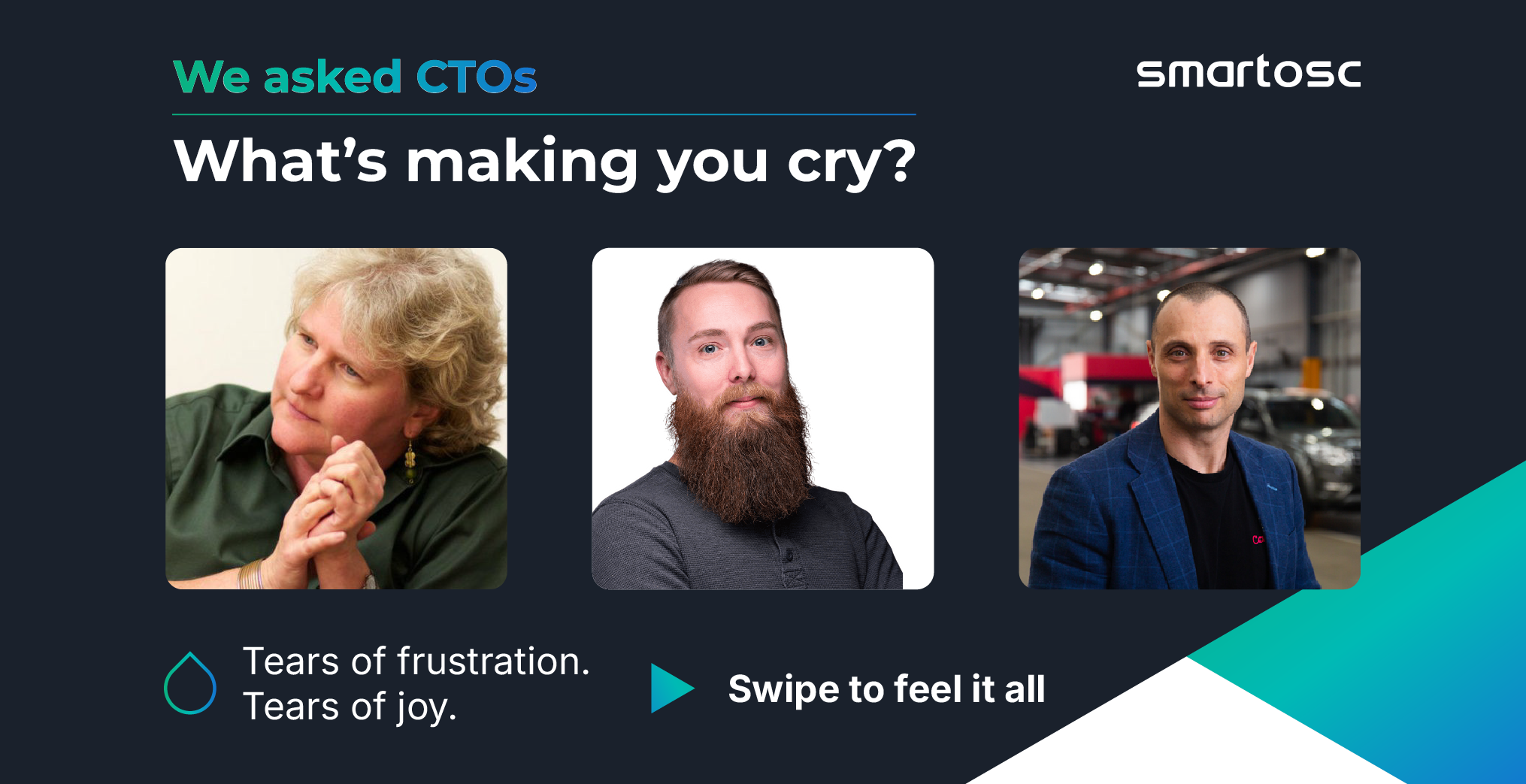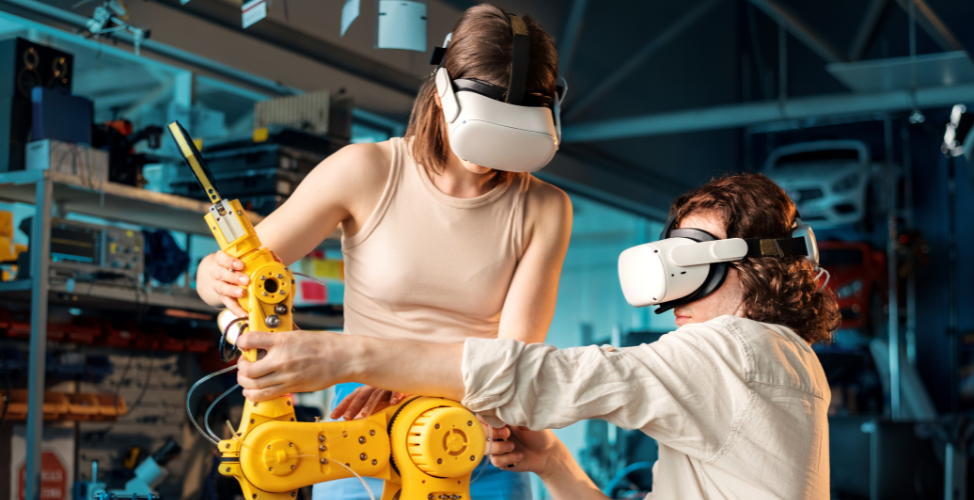August 18, 2025
From Fairy Dust to AGI Tsunamis: Inside the Minds of Today’s CTOs
Tech leaders open up about what’s breaking and what’s brilliant in their world.

The Chief Technology Officer might be the most crucial role in business today, and also the most misunderstood. Over the past three years, demand for the role has increased by 27% across various industries¹. In a global survey of 3,000 CEOs, CTOs (alongside CIOs) were named one of the top three most critical positions in the C-suite².
It’s a job that sits at the nexus of innovation, leadership, digital transformation, growth, and change. A job that comes with high expectations, defined by constant tension between speed and safety, complexity and clarity, vision and viability. It’s a role that rarely looks the same in two companies, yet carries rising expectations across every industry.
If you were to read McKinsey’s A New Dawn for the Technology Officer, you would see that this position could be placed into four types of roles: orchestrator, protector, operator, and builder. We’d argue most CTOs don’t fit into just one; they shapeshift across all four, often in a single day. The job isn’t a category but more an embodiment of consistently competing needs.
And with that alone, we hypothesized that there is a big gap between what we assume and what is actually the reality of the CTO. That’s a problem. As technology becomes more embedded in every part of business and life, we need a better shared understanding of the roles at the helm of change. A gap bridged not by org charts, buzzwords, or wishlists created by everyone outside of their role…but by looking to the humans at the core and hearing their stories.
We wanted to know what’s going on in the minds of the people leading technology and transformation at the highest levels around the world. To find out, we launched Cut the Onion, a podcast mini-series peeling back the layers of today’s CTOs (There was no actual peeling, that would be terrifying). We spoke to technology leaders across the U.S., UK, Ireland, Australia, Thailand, and beyond — we asked about what they do day-to-day, what trends they’re keeping a close eye on…but most importantly, we cut to the chase and asked…What’s making you cry?
Tears of frustration in your industry and tears of joy.
This is part one of a two-part article series.
Rebecca Parsons – Board Member, Author, Speaker, and Former CTO/CTO Emerita of ThoughtWorks
“My single biggest gripe… is the extent to which we believe in magic fairy dust. ‘Oh, AI is now going to solve all of our problems, just sprinkle it and a miracle will occur.’”
Parsons has watched the industry fall, time and again, for frameworks, platforms, and acronyms that overpromise and underdeliver. Whether it’s low-code tools, trendy methodologies, or “the latest magic acronym,” her patience for tech-as-panacea thinking is thin.
“I remember hearing this second-hand… we were doing some exploration around low-code and no-code tools, which for a while were treated like magic fairy dust. The thinking was, “Great! We can get rid of all those programmers because now we’ve got no-code.” And one of the platform salespeople said, “We can do anything in this platform.” My first thought was: That might be technically true.
As long as it’s Turing complete, you could, in theory, write anything in that platform. But whether that’s wise is a completely different story….I’ve been in this business a long time, I’ve seen this cycle again and again. And I’m sorry, but the world is complicated. As our technologies become more capable, we raise the bar on what’s possible. That means we’re tackling more and more complex problems. So to still believe that magic fairy dust exists — that it can make all that complexity disappear — it just drives me nuts.”
Joy: Continuous Delivery and Inclusive Experimentation
Despite the hype fatigue, what brings Parsons joy is how far we’ve come in democratizing experimentation. She sees tools like DORA metrics and daily deployment pipelines not just as engineering wins, but as cultural shifts that empower broader teams — from marketing to legal — to innovate safely and often.
What brings Rebecca joy is how much safer, faster, and more inclusive experimentation has become. Thanks to continuous delivery, fast feedback, and too
“I think one of the most fundamental and substantial changes recently is the introduction of continuous delivery and things like the DORA metrics.”
“If your deployment is risky, you’re not going to do it very often. That means the deployments get bigger, harder to get right, and spaced out in time. And the longer you have to wait, the more you have to guess: What’s going to be important to me in three months? Most of the stuff you throw in, you’re not going to want. We also don’t know where the next disruption is coming from or who the next good idea will come from. One of the fascinating things about ChatGPT is the extent to which people interacting with AI now include lawyers, marketing people, doctors —not just computer scientists. You can experiment if you’re not afraid to experiment. And the discipline of releasing every day — knowing you can celebrate the feature, instead of just not getting yelled at — that’s powerful.”
Florian Pasquier, CTO at Carma
Tears of Frustration: Risk in the SaaS Explosion
“If we anchor that conversation around the industry itself… a side effect of that Cambrian explosion of complexity in the field is the accumulation of SaaS platforms that you have to juggle on a day-to-day basis.”
For Flo, the CTO role at a young company is understanding that you can’t build everything, but more so, it’s about choosing what not to build. As a startup, Carma has to focus on core differentiation and outsource the rest. But with that model comes a risk that needs to be managed with a sharp eye.
“You can’t build everything. You have to focus on what’s really important for your business… and all the rest you outsource into SaaS platforms. That creates so much risk — data proliferation, access control, security…Making sure that all of these identity islands, all of that data, stay secure for our customers. Even though we don’t have millions to spend on security, we still manage that risk profile appropriately. All of that is the real heartbeat of my role at the moment.”
Tears of Joy: Engineers Doing What They Came to Do
What excites Flo most right now is the scale of what small teams can build when equipped with the right tools.
“Since I took the role of Carma, what I think really excited me is the pace at which a small team can build awesome, strong technology muscle and deliver value at scale for our business.”
He credits the democratization of computing through containerization and modern data platforms with removing friction and multiplying the impact of individual engineers.
“When you think about the democratization of computing through containerization and container platform data, platforms at scale such as Databricks or Snowflake — all of these things made our job so easy that an engineer essentially sees their capability multiplied by a factor. When you start leveraging all of these tools in the right way, and therefore having teams only focusing on delivering value and less about the intrinsic plumbing or all of these mechanics — all of that is done for them — I think makes the job so much simpler and so much better for them.”
“Like really focusing on creating value and seeing the team already spending 90% of their time just generating value rather than doing boilerplate or infrastructure… that’s exciting.”
“Of course, infrastructure is still there. That’s why we use our infrastructure as code. We have an entire DevOps practice to make sure that engineers are self-serve and can just be focusing on value.”
…Aaaand finally, someone who we call the CTO whisperer, Joel Beasley AKA the Modern CTO. He’s interviewed over 1,000 CTOs around the world, and here’s what he had to say:
Joel Beasley, Host of the Modern CTO Podcast
Frustration: Denial About the AGI Tsunami
Joel Beasley has interviewed over 1,000 CTOs, but what’s making him cry is the inability of even the most technical minds to see what’s coming.
“The thing that has made me sad recently is people who are really advanced at technology, my peers, their inability to see the tidal wave that is coming. I’m standing on an island and I see a tsunami coming. I can’t tell if it’s two years, three years, or five years away, but I know it’s coming. It’s going to make life entirely different. But there are people who see that tsunami and go, “That’s not really a tsunami, that’s just some clouds in the distance.”
Beasley is talking about AGI. And he’s baffled by how many in the field still dismiss the power of large language models.
“(AGI) It’s getting better exponentially — and it’s just going to happen. But so many people cling to their humanity in some weird sense and say, “It’s never going to replace humans. It’s not as creative as humans.” Then Ethan Mollick released a report showing that in blind tests, humans vote that LLMs are more creative than humans. It’s blind — they don’t know what they’re voting for. So we already agree, as humans, that in certain situations, LLMs are more creative. Just because it’s not here today doesn’t mean it’s not going to be here tomorrow. That blindness really surprised me. I’ve been talking to these people for a decade, and I thought they would see it. But I realized that perception and being able to understand the future is a very different skill set than leadership, engineering, or software development.”
Joy for Joel: Robotics, Modular Reactors, and the Tools That Actually Help
Beasley’s optimism lies in the blend of moonshots and practical tools shaping the near future: humanoid robots that might one day do the laundry, modular nuclear reactors powering data centers, and platforms like Render, SpeakEasy API, and Venice.ai that actually improve developer experience.
“Nothing’s worse in a software developer’s world than a poorly documented API… and they’re making APIs more accessible.”
”So on the small micro level, you’ve got the hosting people, the analytics people doing interesting things with AI, and then the people making APIs better. I think that impacts a large group of people. On the humanity level… I have to mention Venice.ai — big fan. Founded by this guy named Eric Voorhees. They host all the LLM models without the nonsense. They strip out the ideology of the models and just have it do what you want it to do. It’s free — it’s like a ChatGPT-type interface. I’m very excited for their API to come about. Hopefully they’re going to use SpeakEasy, right? We have a couple of internal applications here at our production company that use large language models, and I would love to not have to fight Claude.”
What These Tears Tell Us
If we want better futures built with technology, we have to listen to the people already in the thick of it. Hold the line on complexity, don’t try to bypass it. Be ready for exponential change, especially the kind you can’t yet imagine. Question everything. Magic fairy dust won’t fix it.
At SmartOSC, we work with global brands to design and deliver the kind of digital transformation these CTOs are talking about, building scalable systems, tackling complexity head-on, and creating solutions that last.
To hear more from CTOs around the world, from the trends they’re tracking to the challenges they’re facing — subscribe to The Forward Podcast and explore our Cut the Onion mini-series.
Sources
- TechServe Alliance, CTO Role in ESG and Business Transformation, 2023.
- IBM Institute for Business Value, The CTO Revelation: A New Era of Leadership, 2021.
- Digital Defynd, Surprising Facts About CTOs in 2024
Related blogs
Learn something new today


